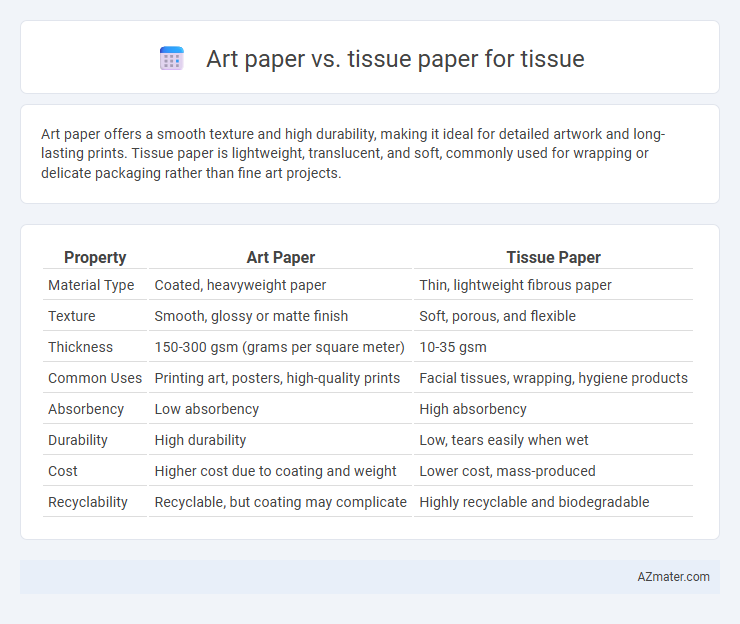Art paper offers a smooth texture and high durability, making it ideal for detailed artwork and long-lasting prints. Tissue paper is lightweight, translucent, and soft, commonly used for wrapping or delicate packaging rather than fine art projects.
Table of Comparison
| Property | Art Paper | Tissue Paper |
|---|---|---|
| Material Type | Coated, heavyweight paper | Thin, lightweight fibrous paper |
| Texture | Smooth, glossy or matte finish | Soft, porous, and flexible |
| Thickness | 150-300 gsm (grams per square meter) | 10-35 gsm |
| Common Uses | Printing art, posters, high-quality prints | Facial tissues, wrapping, hygiene products |
| Absorbency | Low absorbency | High absorbency |
| Durability | High durability | Low, tears easily when wet |
| Cost | Higher cost due to coating and weight | Lower cost, mass-produced |
| Recyclability | Recyclable, but coating may complicate | Highly recyclable and biodegradable |
Introduction to Art Paper and Tissue Paper
Art paper is a high-quality, thick, and durable paper commonly used for printing fine art, photography, and professional projects due to its smooth texture and ability to hold ink without bleeding. Tissue paper, on the other hand, is a lightweight, translucent paper primarily used for wrapping, cushioning delicate items, and crafting because of its softness and flexibility. The key differences lie in their weight, opacity, and intended use, with art paper providing superior durability and visual clarity compared to the delicate and porous nature of tissue paper.
Understanding the Composition of Art Paper
Art paper, primarily composed of wood pulp with added clay coatings, offers a smooth, durable surface ideal for producing vivid images and fine details. In contrast, tissue paper is made from lightweight cellulose fibers, resulting in a thin, delicate texture designed for softness and absorbency rather than strength. Understanding the fiber density and coating differences highlights why art paper supports intensive printing techniques while tissue paper remains suited for gentle applications like facial tissues.
What Defines Tissue Paper?
Tissue paper is a lightweight, thin paper primarily used for wrapping, cushioning, and decorative purposes, characterized by its soft texture and high absorbency. Unlike art paper, tissue paper is semi-transparent and less durable, making it ideal for delicate applications such as gift wrapping, stuffing, and hygiene products. Its porous structure and low grammage differentiate it from the thicker, more rigid art paper used for printing and crafts.
Major Differences Between Art Paper and Tissue Paper
Art paper features a smooth, coated surface ideal for high-quality printing with vibrant colors and sharp details, making it suitable for artistic and professional uses. Tissue paper is lightweight, thin, and semi-transparent, primarily used for wrapping, cushioning, and decorative purposes due to its softness and flexibility. The major differences lie in their texture, thickness, and intended functionality, with art paper offering durability and color fidelity, whereas tissue paper emphasizes delicate protection and aesthetic appeal.
Applications of Art Paper in Tissue Production
Art paper in tissue production enhances print quality and durability, making it ideal for premium facial tissues and decorative packaging. Its smooth surface allows for high-resolution printing, which is essential for branded tissue products and luxury napkins. Using art paper also improves tissue strength and absorbency, contributing to a superior user experience in bathroom and kitchen tissues.
Uses of Tissue Paper in Art and Everyday Life
Tissue paper, known for its lightweight and translucent properties, is extensively used in art for creating delicate decorations such as flowers, collages, and paper mache due to its flexibility and ease of layering. In everyday life, tissue paper serves practical roles including gift wrapping, cushioning fragile items, and providing decorative touches in packaging. Its versatility and affordability make tissue paper an essential material for both creative projects and routine household tasks.
Strength and Durability: Art Paper vs Tissue Paper
Art paper offers significantly higher strength and durability compared to tissue paper due to its denser fiber composition and specialized coating, making it ideal for projects requiring longevity and resistance to wear. Tissue paper is lightweight and delicate, prone to tearing and less suitable for applications demanding robustness. These inherent differences impact their usability in various artistic and practical contexts.
Environmental Impact and Sustainability
Art paper and tissue paper differ significantly in environmental impact and sustainability; art paper, often made from wood pulp with chemical treatments, can have a higher carbon footprint and less biodegradability. Tissue paper is typically more biodegradable and compostable, especially when produced from recycled fibers or sustainably sourced materials, reducing landfill waste. Choosing tissue paper with certifications like FSC or made from recycled content enhances sustainability by promoting responsible forestry and lowering resource consumption.
Cost Comparison: Art Paper vs Tissue Paper
Art paper generally costs more than tissue paper due to its thicker composition and higher-quality finish, making it ideal for premium packaging and artistic projects. Tissue paper is significantly cheaper, often used for lightweight applications such as gift wrapping or cushioning, allowing for cost-efficient bulk purchases. Businesses seeking budget-friendly solutions typically prefer tissue paper, while those focusing on durability and appearance opt for art paper despite the higher expense.
Choosing the Right Paper: Factors to Consider
Choosing between art paper and tissue paper for tissue production involves evaluating factors such as texture, absorbency, and durability. Art paper offers a smoother surface and higher opacity, making it suitable for luxury tissue products, while tissue paper excels in softness and biodegradability, ideal for everyday hygiene use. Cost-effectiveness and environmental impact also play crucial roles in selecting the appropriate paper type for specific tissue applications.

Infographic: Art paper vs Tissue paper for Tissue
 azmater.com
azmater.com